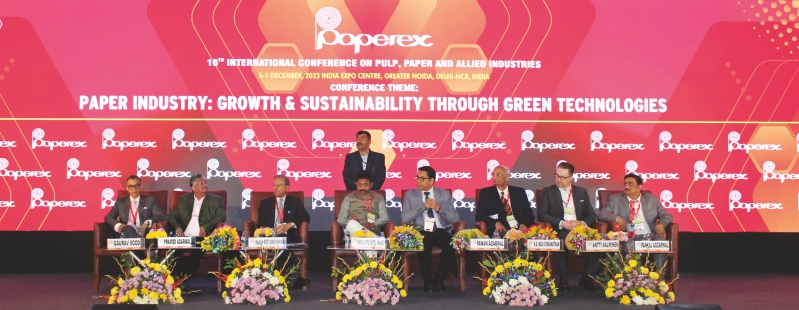The 16th edition of the world’s largest paper show and technical conference organized by Hyve India Private Limited with the support of Indian trade bodies, showcasing the latest technological developments in the pulp, paper and allied Industries, Paperex 2023, was held at India Expo Centre, Greater Noida from December 6-9 on the theme ‘Paper Industry- Growth & Sustainability Through Green Technologies.’ Paper Mart magazine extensively covered the four-day event of Paperex 2023, to highlight and bring to our readers the developments and innovations taking place in the pulp, paper and allied industries.

The unified business platform for the paper industry, which showcased new business opportunities, joint ventures and investments in technological advancements in the paper and allied industries, witnessed huge participation from a large number of paper & board manufacturers, paper traders, printers, publishers, converters and paper packaging companies, designers for corrugated box & related packaging, manufacturers showing new technologies, machinery, equipment and raw material, investors, and promoters.
The inaugural ceremony was graced by Mr. Nand Gopal Gupta ‘Nandi,’ Minister of Industrial Development, Export Promotion, NRI & Investment Promotion, Government of Uttar Pradesh, along with stalwarts of the pulp, paper and allied industries.
Those present on the occasion included Mr. Pramod Agarwal, President of Indian Agro & Recycled Paper Mills Association (IARPMA) and Chairman of Rama Paper Mills Ltd; Mr. Harsh Pati Singhania, Chairman of Development Council For Pulp Paper & Allied Industries, Vice Chairman and Managing Director of JK Paper Limited, Director of JK Organization; Mr. Pawan Agarwal, President of Indian Paper Manufacturers Association (IPMA) and Managing Director of Naini Paper Mills Limited; Mr. KS Kasi Viswanathan, Chairman of Technical Committee Paperex and MD, Seshasayee Paper & Boards Limited; Mr. Antti Salminen, President of Pulp & Paper Segment at Kemira, Finland; Mr. Gaurav Sood, General Manager, Hyve India Private Limited, and Mr. Pankaj Agarwal, Vice President of IARPMA and MD, Bindlas Duplex Limited.

Nand Gopal Gupta: “Paper is of utmost importance and an integral part of our society. From a child scribbling alphabets on a notebook to a Cabinet Minister writing orders and laws, everything is written on paper. Paper as a currency has a lot of value. If you have that paper, you can buy anything from a cycle to a plane. For the growth of the pulp and paper industry, it is important to provide solutions and innovations to the challenges currently being faced by it. There are a total of 904 mills in India’s paper industry and out of these, 104 are located in Uttar Pradesh. UP has been a frontrunner in the development and growth of this industry since British Rule.”

Pramod Agarwal: “Paper industry in India is one of the fastest-growing industries in the world, which is expected to meet the rising demand within the next decade. The importance of this exhibition is to sustain the growth of the Indian paper industry through the adoption of technology and innovation to sustain the emerging threats that were faced by the industry.”

Antti Salminen: “India is the fastest-growing pulp and paper market in the world. The future for the industry globally is here and it’s a great opportunity to meet colleagues from different areas of the industry, to build a more sustainable and greener future for this planet together. When I studied in the university back in the early nineties, everybody in Finland told me that the pulp & paper industry was a sunset industry. We together have proven that it is not. This industry has reinvented itself and will be reinventing itself over and over again, to enable this world to develop further in a sustainable manner. Wood-based fiber is the most sustainable raw material that we can use. All the technical advancements, both in technology and hardware, along with the applications in the pulp & paper industry, will be the way forward to a more sustainable future.”

Pawan Agarwal: “IPMA represents a large chunk of paper industry in the country today. It is understood to be having some kind of pulse of the present and future of the paper industry, at least in India. Right now, the pulp and paper industry is facing a lot of challenges, but where there are challenges, there are opportunities. We use waste paper to make various kinds of paper and board.
The biggest challenge faced by the paper industry right now is the low availability of raw material. We have to understand one very important aspect – the proportion of raw material being used in our industry. Around 28 years ago, the mix used in the paper industry was one-third wood based, one-third agro based, and one-third recycled fiber based. This mix has undergone huge change and today, it is 20 percent wood-based, only five percent agro-based and a whopping 75 percent is recycled fiber-based. The recycled fiber-based industry is dependent on imported raw material.
Our virgin fiber based product is only 25 percent and the collection rate is around 50 percent, which means there is a huge deficit of raw material in India. However, we have a solution to this – trees. Today, tree or fresh wood timber is the best possible natural resource a country can have, after oil. Timber is the only natural resource that can be grown within 4-5 years by farmers in their farms and on agricultural lands. The pulp and paper industry wants to take up the tree plantation drive across the cou
try through various mediums such as agro forestry, social forestry, private means, government or NGOs.
If we don’t collectively move towards planting trees, we will soon have a lot of inbuilt capacity but no fiber availability. We will be totally dependent on imported waste paper and imported pulp. There are multi-fold advantages of initiating this drive. It will have a positive impact on the environment, contribute towards carbon sequestration, generate employment in a big way and also improve the income of farmers drastically. It is a win-win situation for all. There cannot be a more sustainable program than going for a tree plantation drive.
The paper industry in India has come of age. We are trying to live with our limitations of quite low economies of scale and the operations of scales. Our mills produce 100-200 TPD or even less, but we have been able to adapt to the world class technologies in our limited small capacities. This is one good thing the paper industry has done in the past one decade.
There’s a feel good factor in the air when we talk about paper because everybody says that the menace of plastic, rather single-use plastic, can be handled by using more and more paper. Paper is both eco-friendly and bio-friendly. Though the industry agrees that paper has got that inherent advantage, we need to look at our paper manufacturing processes, whether they are equally environment friendly or not. Today, we have technologies, which can be used to make our manufacturing processes, right from the procurement of raw material to treatment, environment friendly. Let us explore those technical opportunities and see how we can make our manufacturing processes more environment-friendly and sustainable.”

Harsh Pati Singhania: “Though the world economy is going through frequent disruptions, amidst such heightened uncertainty, the Indian economy is exhibiting great resilience. Thanks to our leadership, India is projected to be the only major economy to grow at a robust pace, which will propel the country to be the third largest economy in the next few years. This scenario is replicated in the paper industry, as falling demand in advanced economies, especially in the graphic paper segment, has led to new capacity investments moving to Asia and in pulping to South America.
In the last two decades, almost 60 percent of global new paper machine investments went to the Asia-Pacific region. Every type of modern fiber, paper and board-making technology ranging from entry-level solutions to state-of-the-art, high-speed machines and high-quality production lines have been deployed by the Asian pulp and paper producers. About 50 percent of global paper demand is in Asia, of which India is the fastest growing market in the world, expected to grow at about 4-5 percent CAGR in at least 2030.
According to various studies, the consumption of paper and board in India is expected to grow over 35 million tonnes by 2035 from approximately 22 million tonnes presently. Greater emphasis on education and literacy by the government coupled with growth in the business & commerce sector, and demand for better quality paper by environmentally conscious consumers are some of the major drivers in the writing and printing segment.
Demand for better quality packaging of FMCG products marketed through organized retail, booming e-commerce, rising healthcare spend, demand for over-the-counter medicines, and an increasing preference for ready-to-eat foods are the major drivers for paperboard.
Watch: Starkraft to Offer Capacity of 350,000 tons from May 2024
Aqueous coatings are increasingly replacing polyethylene packaging across various food categories with new products offering oil and water resistance, moisture & oxygen barrier, and heat sealable capacities. In addition to meeting customer expectations, they also help the industry in gaining a competitive advantage as paper and board are biodegradable and sustainable products.
However, it is not simply enough to say that paper can be an alternative to plastics and other materials. Papers & boards must perform and meet the test of both performance and price if we are to successfully succeed. There is a need for the industry to innovate, develop and find methods & technologies to be able to deliver this promise.
The Indian paper industry is an excellent example of Aatmanirbhar (Abhiyan). Right from its inception over one-and-a-half centuries ago, it has been producing paper in India. The industry is largely capable of meeting the requirements for domestic capacities as it has been doing in the past. Imports are restricted to certain varieties. The integrated paper mills are also investing heavily in the latest technology available globally, whether it is state-of-the-art pulp mills or high speed new generation paper machines. More than INR 25,000 crore or approximately USD three billion have been invested in sustainable production processes in the last few years alone.
The Indian paper industry has agro forestry roots and strong backward linkages with the farming community. Wood, which is a key raw material, is sourced from farmers. Of the total demand for wood, over 90 percent is sourced from industry-driven agro and farm forestry sources. The rest comes from the government and some other sources.
Today, we can perhaps say that the Indian paper industry is wood positive. If not all mills on an aggregate, JK Paper is a wood and carbon positive company.
Substantial amounts have been spent by the paper industry on R&D plantation for the production of high quality kernel saplings, technical extension services to improve agro & farm forestry, and hand holding of marginal farmers. In India, an estimated five lakh farmers are engaged in growing plantations of different species. On an average, about 125,000 hectares are being brought under agro and farm forestry annually. This has generated ample employment opportunities for locals in the farm and rural areas, while also significantly supplementing the income from farmers.
“The integrated paper mills are also investing heavily in the latest technology available globally, whether it is state-of-the-art pulp mills or high speed new generation paper machines. More than INR 25,000 crore or approximately USD three billion have been invested in sustainable production processes in the last few years alone.”
The use of clonal development to bring farm forestry yield at par with the best in the world has resulted in plantation activity increasing by over 54 percent in the last five to six years. In addition to sustainable farm forestry practices and responsible sourcing of raw material, the Indian paper industry has been making strides in efficient resource management through reduced energy and water consumption in paper making. Most of the industry actions are being done voluntarily, essentially on three key fronts. Reducing energy intensity of business, increasing use of renewables, and achieving water efficiency by reducing the water footprint.
The paper industry is also in a strong position to make contributions towards achieving a net zero economy by increasing our share of renewables. The new paper machines with wider widths, faster speed and more automation & sophistication have given a major fillip to the efforts in resource conservation, resulting in sharp reduction in specific unit consumption of resources needed. This is reflected in the work done by our mill, where even after doubling paper production, we still use the same amount of power and water.
The pulp and paper market in India is clearly stepping into a new era. The predicted growth in paper and paperboard consumption not only brings huge potential for the Indian industry, but also challenges, which need to be tackled. The current projection of future demand, which will increase by 13 million tons in the next 10-12 years, will require new solutions. One of the major challenges faced by the industry is the sharp rise in import of various grades of paper.
Also Read: Paper Mart Emagazine Dec-Jan, 2023-24
After a 25 percent jump in volumes in the last year, paper imports have risen further by 43 percent in the first half of this year alone. The surge in imports is mainly due to a three-fold increase in imports of paper and paperboard from the ASEAN region, which arrived at zero import duty under a free trade agreement. While imports of all grades of paper have risen sharply, imports of uncoated writing and printing paper have witnessed the largest jump.
Imports are expected to accelerate further in view of the economic slowdown in China, the trade restrictions imposed by the US & the European Union, and the large new paperboard capacities coming up in Indonesia and China.
“Of the total demand for wood, over 90 percent is sourced from industry-driven agro and farm forestry sources. Today, we can perhaps say that the Indian paper industry is wood positive.”
Even as the industry grapples with the issue of producing paper and paper board at competitive prices, the high cost of wood based raw materials for those who have not been doing plantation, coupled with a significant increase in fuel cost and other inputs has resulted in a substantial increase in the cost of domestic manufacture of paper and paperboard, posing an additional headwind.
The waste paper recovery mechanism is not yet mature enough and the present recovery rate is barely 40 percent, which forces the industry to depend more on imports. Moreover, high logistic costs and high cost of capital have made the Indian market amenable to imports, leading to underutilization of domestic production capacities. While paper industries’ plantation activities have been going well, the overall raw material availability for wood-based industries is not enough to meet the projected demand.
“In addition to sustainable farm forestry practices and responsible sourcing of raw material, the Indian paper industry has been making strides in efficient resource management through reduced energy and water consumption in paper making.”
The government needs to consider a policy that would enable the wood-based industries to have plantations established with raw material linkages by various industries. The industry, on its part, also needs to focus on recycling and use of other agri-inputs, even though there are limitations to this. To be able to cater to the expanding market, the industry has to take measures to upgrade to the existing technology for better efficiency and quality.
Greenfield capacity with high speed new generation machines would give a major boost to these efforts and also in resource conservation. Technology suppliers can be sensible partners in evaluating the pros and cons when defining the best investment targets.
Issues related to the environment management and business practices that would come in with a new digital economy also need to be addressed. While we see different challenges coming from the digital economy, we believe that paper will still remain the future.”



